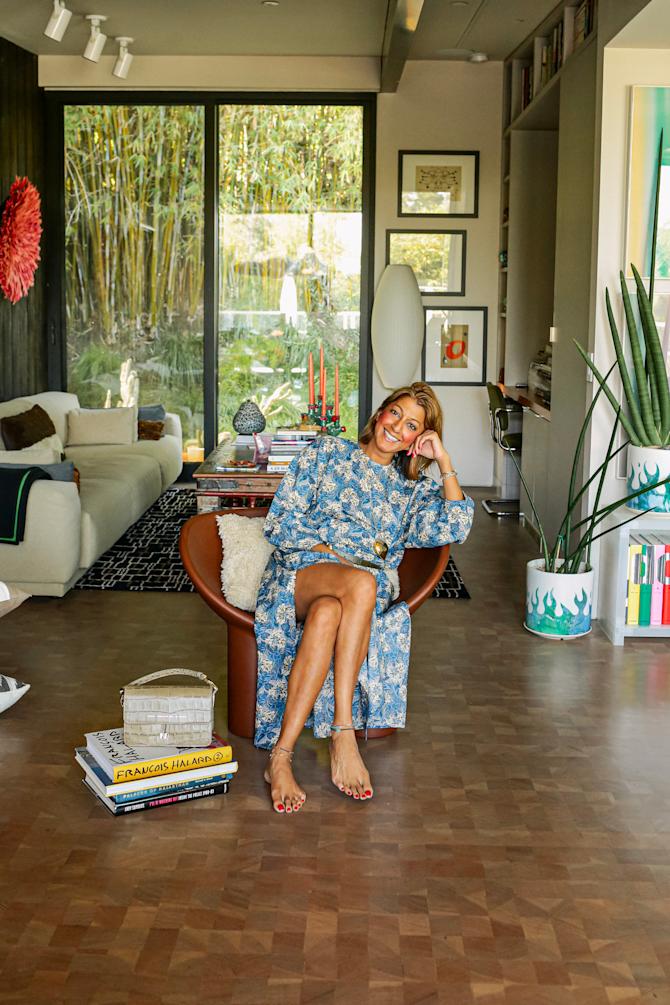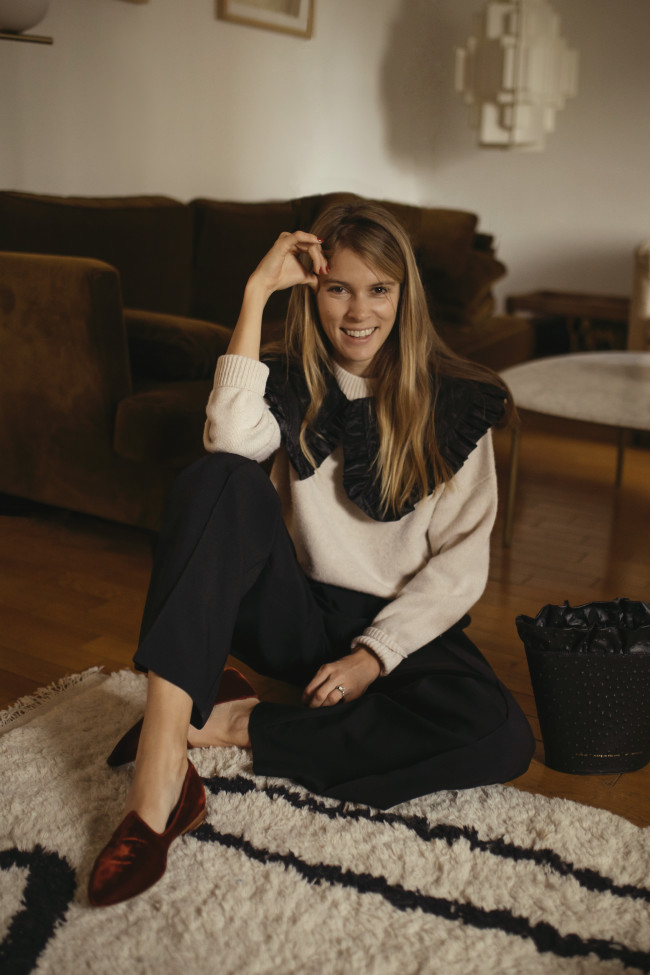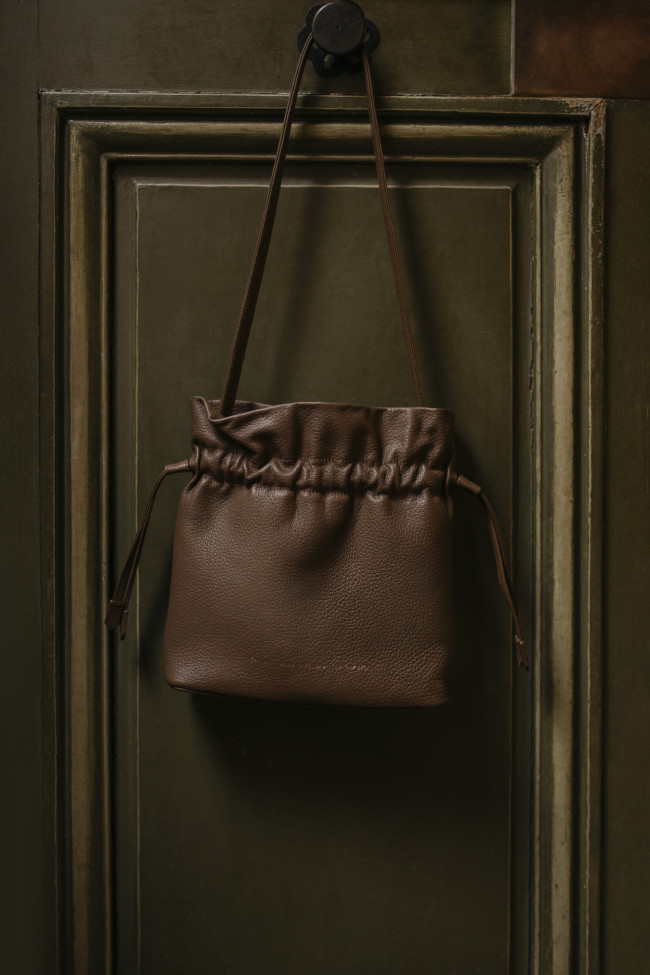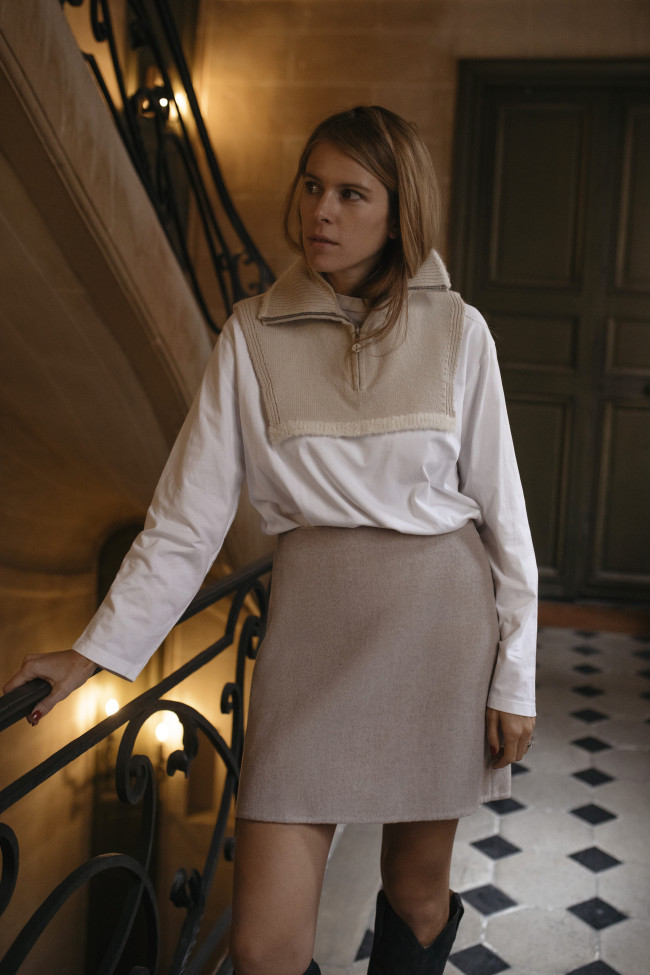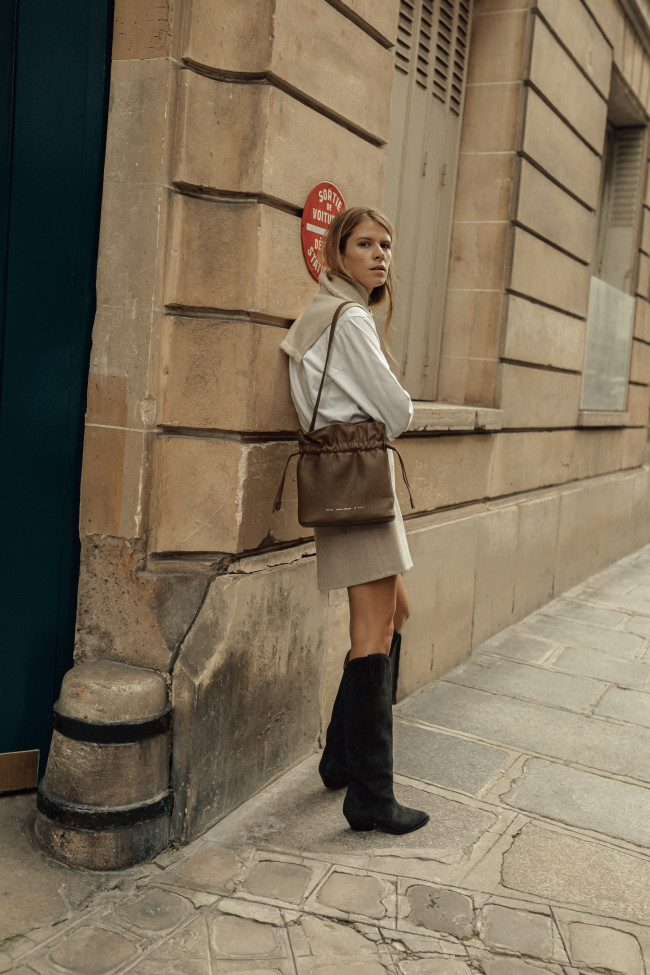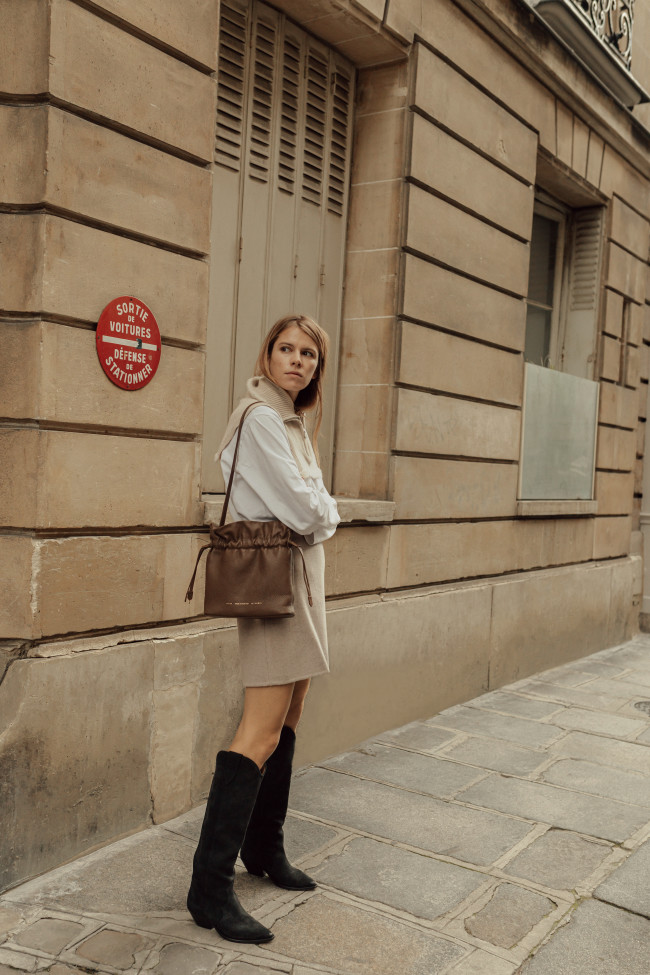Monica Ainley de La Villardière
By: Maja Von Horn
Photography: Asia Typek
There are different ways of being an influencer. There is this basic level of “I wear it, you buy it”, and we all do it. But there is also something like real influence — influencing thought, being a thought leader, influencing lifestyle choices. It has existed throughout history, the difference is that now we are all looking at it on our phones – says fashion journalist Monica Ainley de La Villardière, a Canadian expat in Paris, famous for her effortless style as much as her sharp sense of humour.
Maja von Horn: You grew up in Toronto, but have been living in Paris for a few years now. Why did you decide to leave Canada for Europe?
Monica Ainley de La Villardière: Toronto is an amazing place, which offers an exceptional quality of life. A lot of people want to go and live there, and I really get why. I’m very proud to be Canadian. But the European way of life always appealed to me personally. I’ve been lucky enough to travel a lot when I was younger, which opened my mind. Some of my family is British, and I moved to the UK when I was eighteen to go to University of Edinburgh to study English literature and French. During my third year I did an exchange programme in Paris, at the Sorbonne. Then I went back to Edinburgh to finish my undergrad degree, and afterwards, I moved to London to do a masters in journalism. My life progressed in a way that didn’t lead me back to Toronto. And I feel very happy and settled in Paris. There’s just something about it I love, a certain “je ne sais quoi.”
M.V.H.: While studying journalism you did an internship for British Vogue. Is that when your career in the fashion industry started?
M.A.: I think it started back in my childhood. My grandmother June Ainley was a big fashion person, it was thanks to her that I realised that fashion can be a career. I also loved journalism and communications, so I thought it would be cool to marry the two. My grandma was a fashion model back in the days when there were in-house models. She worked for the house of Carven in Paris with Madame Carven right after the war. Before that she worked for Hardy Amies in London. In those days models didn’t run from one show to another, they would actually have tea with clients, so that they could see how the clothes look in real-life situations. She later married a Canadian, my grandfather, and moved to Montreal, where she lived for the rest of her life. She was a fashion icon there, very well-known for her style. June was very, very British. People in Canada thought she was extremely glamorous. Canada has a lot of nice things about it, but fashion isn’t its raison d’être. It has the most beautiful nature, the cities are really modern, with great food. It’s like Australia, but cold.
M.V.H.: Your style is often inspired by menswear, was your grandma influenced by it too?
M.A.: Menswear was totally part of her style as well. It was really simple, never too much. “Too much” was her worst nightmare. She wore her husband’s shirts all the time – she would tuck them in some nice trousers, done up in the waist with some beautiful belt and a big Hermès bracelet, which I own now. We’re very different when it comes to hair though – mine is very wild and long, and hers was short and sleek, always done up. I have a picture of her from a magazine from 1989 — she was still modelling when I was born, when she was in her 60s and a grandmother. It hangs in our bathroom, along with some other pictures of my husband’s and my families, to keep our guests entertained.
M.V.H.: As a fashion journalist, has it always been a dream of yours to move to Paris?
M.A.: It’s definitely very useful to be here when you work in fashion. My husband is from Paris, and although I come from the English-speaking part of Canada, I learned French at a very young age, so I thought I might just as well use it. I really like Paris, it’s absolutely stunning, and I am quite an aesthetic person – I like to be surrounded by beauty, it makes me happy. People think that the French are rude, but I think they’re just honest. They can be rude too, but if you push them back a bit, you can usually break through to them. I appreciate their respect for living well and for work-life balance. And also their respect for the creative industry, which doesn’t necessarily come through as much in certain circles in North America. Art is valued in France, and so is fashion, it’s a big business here. So if you work in one of those industries, it’s a good place to be.
M.V.H.: Has your style changed in any way since you settled in Paris?
M.A.: I’ve always dressed quite simply. I appreciate the trends, I don’t think it’s anything bad to dress trendy, but it has never been my thing. I’m more about finding what works for me.
M.V.H.: One of the things that work for you are Chylak handbags.
M.A.: Yes, I really like the beautiful, neutral colours they have, you can wear them with everything. I also love that they’re sustainable.
M.V.H.: When living in London, you launched a podcast “Fashion: No Filter” together with fellow influencer Camille Charrière. Are you planning to go back to doing it again?
M.A.: Today there is this joke going around that everybody has a podcast now. This wasn’t the case back in 2016 when we came up with the idea. I don’t think there was another big podcast about the fashion industry back then. We were both big radio fans, and I had learned how to do radio as part of my journalism degree. I loved the idea of interviewing interesting key players in the industry to figure out what makes them tick. In the last season we had Loic Prigent [creator of insider documentaries that dissect the fashion world], Alexandre de Betak [producer of the biggest fashion shows in the industry]. We interviewed most people we wanted to interview, and it was never a business venture, but a journalistic one. If we were to do it again, we’d have to monetise it better, since it takes up so much time. For three years Camille and I spent so much time doing this, that we needed to put it on hold to focus on other projects.
M.V.H.: You became a mother eight months ago, was that one of the reasons for a little break?
M.A.: Honestly, I thought taking care of a baby was going to be harder than it is. It adds so much more to my life! But I’m very privileged to have great childcare for my daughter Mia — the French have an amazing daycare system — so I can balance work and motherhood.
M.V.H.: Has motherhood changed your viewpoint on anything?
M.A.: If anything, it makes me want to work harder, to make her have a wonderful life. I love my work, I think that working hard and doing what I love actually makes me a better mother. I’m not exhausted by taking care of a child 24 hours a day, and so when I come home I’m very excited to see her and I can be 100% present as a mother.
M.V.H.: A few months ago you wrote a very good article for British Vogue about being an influencer in the Covid era in which you talk with a number of influencers about what’s still appropriate to post and what’s not. Has it felt wrong to go on with business as usual when the pandemic started?
M.A.: From a financial standpoint, a lot of people were losing their jobs, so pushing products during the first lockdown felt rather inappropriate. But there are different ways of being an influencer. There is this basic level of “I wear it, you buy it”, and we all do it. But there is also something like real influence — influencing thought, being a thought leader, influencing lifestyle choices. It has existed throughout history, the difference is that now we are looking at it on our phones. I didn’t think that there was no room for influencers anymore, in fact, I thought that we’re very lucky to have this technology that connects us. The core of this article was that it was worth evaluating the manner in which we were influencing each other at that very particular time.
M.V.H.: How can you use your platform to do more than “pushing product”?
M.A.: You can highlight creativity that wouldn’t necessarily get a chance to be highlighted otherwise. You can propose new ways of looking at situations. Instagram is a medium like any other. If you’re lucky to have that platform, you’re the one who decides how to use it. However, activism has its downfalls as well. We have to be very wary of feeling that we’re saving the world by putting the link to GoFundMe for Afghanistan (which by the way I did, when the Taliban came in, because I didn’t know what else I could do). I also shared links to charities that I checked beforehand to make sure they weren’t fake. It’s important to not feel that I’m a really great person just because I did that. There are people who don’t want to engage, and I respect that. They’re on social media just for their art and creativity, and that’s cool too. But if you have a big platform, I think it is worth occasionally asking yourself “Can I be any more helpful than just purely selling fashion”?
M.V.H.: So the bigger the platform, the bigger sense of responsibility?
M.A.: Yes, but we should also be careful here. When there are world conflicts, there are a lot of people who expect influencers to take a side and say, for instance, “I stand with Palestine”. And if you don’t say that, it means you’re against it. It’s always “you’re either with us, or against us”. I don’t want to say that I stand with Palestine, and I don’t want to say that I don’t either. I simply don’t want to make a pronouncement on what is the most complicated conflict in modern geopolitical history. I don’t think I’m well placed to talk about it — I’m educated, but not specifically in that conflict, I read a newspaper like everyone else. There are moments when I actually shut the fuck up, and I find it hard when people don’t understand that.
Monica's Paris Favorites
- Cafe de La Mairie, in front of Eglise St Sulpice in the 6th for coffee or after-work drinks with a beautiful view
- Le Maquis on Rue des Cloys in the 18th for a delicious, intimate modern bistro
- Le Mary Celeste in the Marais for date night with great drinks and snacks at the bar
- Le Bon Marche in the 6th for all the shopping you could dream of under one roof
- Le jardin du Luxembourg for the most beautiful autumn walks!
